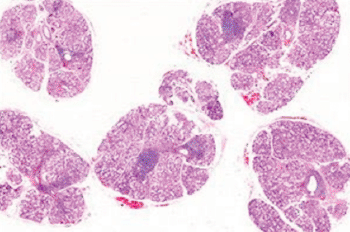Six Additional Sjögren's Syndrome Genes Identified
By LabMedica International staff writers
Posted on 23 Oct 2013
The first genome-wide association study for Sjögren's syndrome has been completed and six new disease-related genes have been identified.Posted on 23 Oct 2013
Sjögren's syndrome is an autoimmune disease in which the immune system becomes confused and turns against the body's moisture-producing glands, damaging the ability to produce saliva or tears.

Image: Photomicrograph of a salivary gland with sites of inflammation indicative of Sjögren's syndrome (Photo courtesy of US National Institute of Dental and Craniofacial Research).
Scientists at the Oklahoma Medical Research Foundation (Oklahoma City, OK, USA) working with international collaborators, collected from around the world about 2,000 patient samples, which were tested against more than 7,000 healthy controls. They found variants at multiple loci implicated in both innate and adaptive immune responses that are associated with Sjögren's syndrome.
Genotypes for the groups were obtained using the Omni1-Quad array and Infinium chemistry (Illumina; San Diego, CA, USA). The results were exactly what the investigators were hoping to see. In addition to the previously known human leukocyte antigen (HLA) gene related to the disease, the group was able to identify six new Sjögren's genes and begin working to understand their functions.
The disease related genes found were the interferon regulatory factor 5 (IRF5) and the signal transducer and activator of transcription 4 (STAT4) which are both master regulators that activate cells during an immune response; the chemokine (C-X-C motif) receptor 5 (CXCR5) gene that directs traffic for lymphocytes and may help explain why immune cells target moisture-producing glands. Two other genes were found that affect the immune system the autoimmune disease-related gene, tumor necrosis factor, alpha-induced protein 3 (TNFAIP3), and it binding partner TNFAIP3 interacting protein 1 (TNIP1).
The other two genes were the Interleukin 12A (Natural Killer Cell Stimulatory Factor 1, Cytotoxic Lymphocyte Maturation Factor 1, IL12A) which is one subunit of a protein that acts as a messenger between cells and modulates immune responses, and the B lymphoid tyrosine kinase (BLK) is a B-cell gene which might account for increased numbers of antibodies.
Christopher J. Lessard, PhD, the lead author of the study said, “This is a first step. Now that we've identified these genes, we can dig down and start to understand how these genetic variants alter normal functions of the immune system.” Kathy L. Sivils, PhD, the senior author, added, “One problem has always been identifying true Sjögren's patients and collecting enough samples, partly because there's still disagreement on the criteria for the disease and clinical testing is not easy. So much work goes into classifying patients that it makes building collections of samples more difficult." The study was published on October 6, 2013, in the journal Nature Genetics.
Related Links:
Oklahoma Medical Research Foundation
Illumina













